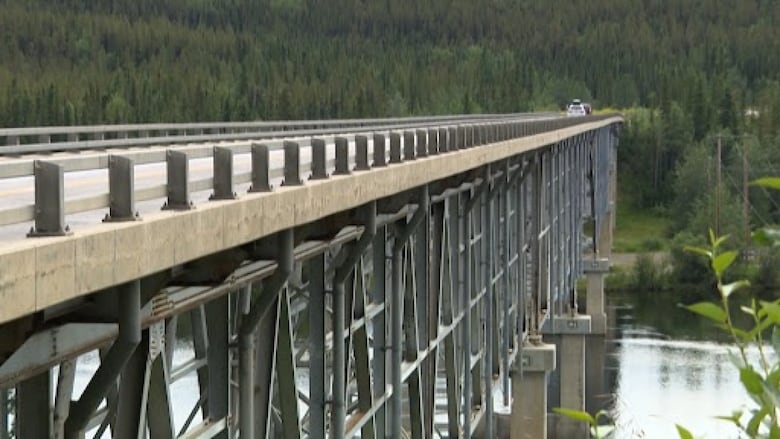Yukon government plans repair work on Teslin River Bridge
Project estimated to cost $15M to $20M, with work to begin in 2027

The Government of Yukon is seeking approval to repair damage on the Teslin River Bridge near Johnsons Crossing.
Exposed steel bars, cracked concrete on piers, and pressure on a pier from soil under the south abutment are all problems the Government of Yukon plans to fix as part of the repair project.
The bridge spans the Teslin River near the intersection of the Alaska Highway and the South Canol Road.
A temporary trestle bridge and two underwater structures would need to be built prior to the repair work, to give crews access to the structure. Soil anchors would then be installed at the feet of the affected piers to stabilize the south end of the bridge.
In the meantime, the government says the bridge is still safe to drive on, and it's not expected to become unsafe in the near future.
"Ultimately, everything will help make sure that the bridge is safe in the long term and that it continues to be stable so it can withstand natural events like flooding, earthquakes and strong winds," said Antoine Goulet, a spokesperson for Yukon's Department of Highways and Public Works.
The estimated cost of the project is between $15 million and $20 million. The work is planned for 2027-2028.
Officials say the highway in the area will remain open throughout the repair work, though there may be some temporary impacts on traffic.
Goulet says the government will try to hire local contractors for the project.
"We're gonna be working with the Teslin Tlingit Council and the Teslin community to make sure that the procurement of the work that we'll be doing on the bridge benefits the community economically as much as possible," he said.
Derek Kingston, the government's environmental coordinator, said he heard concerns from the Teslin Tlingit Council about potential impacts on migrating chinook salmon in the Teslin River. He said the government will take measures to protect fish and the environment, including implementing any recommendations from the Yukon Environmental and Socio-Economic Assessment Board (YESAB).
"We'll ensure a fish exclusion zone is scanning for fish before some of the in-stream work occurs, and as well, we're going to try to minimize the in-stream footprint from the project… so we don't impact fish and fish habitat," Kingston said.
Applications to YESAB and to Fisheries and Oceans Canada will be submitted by the end of July. Additional applications to the Yukon Water Board and Transport Canada will also need to be approved prior to construction.